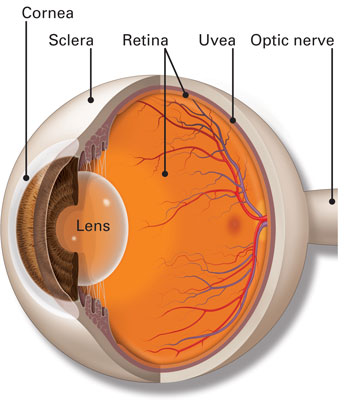What is Uveitis?
Uveitis occurs when the middle layer of the eyeball gets inflamed (red and swollen). This middle layer, called the uvea, has many blood vessels that nourish the eye. Uveitis can damage vital eye tissue, leading to permanent vision loss if left untreated.
Three types of uveitis
There are 3 types of uveitis. They are based on which part of the uvea is affected.
Swelling of the uvea near the front of the eye is called anterior uveitis. It starts suddenly and symptoms can last up to 8 weeks. Some forms of anterior uveitis are ongoing, while others go away but keep coming back.
Swelling of the uvea in the middle of the eye is called intermediate uveitis. Symptoms can last for a few weeks to many years. This form can go through cycles of getting better, then getting worse.
Swelling of the uvea toward the back of the eye is called posterior uveitis. Symptoms can develop gradually and last for many years.
In severe cases, all layers may be involved.
The cause of uveitis is sometimes unknown. You are more likely to get uveitis if you have or have had:
- infections such as shingles virus, herpes simplex virus, syphilis, Lyme disease, and parasites such as toxoplasmosis.
- a systemic inflammatory disease such as inflammatory bowel disease (IBD), rheumatoid arthritis, or lupus
- an eye injury
- smoked- cigarettes, cigars or pipes all increase your risk of getting uveitis.
Uveitis can develop suddenly. Common symptoms can include:
- having a red eye with or without pain
- sensitivity to bright light
- blurry vision
- sudden onset of seeing “floaters” (specks or moving clouds) in your vision
Contact Dr. Banik right away if you notice any of these symptoms. She will examine the inside of your eye.
Since uveitis is often connected with other diseases or conditions, some tests may be needed. They may include a physical exam, blood or skin tests, examination of eye fluids, and imaging tests, such as X-rays. Dr. Banik may ask about other diseases or health problems you have had.
How is uveitis treated?
Uveitis needs to be treated right away to prevent lasting problems. Initially, uveitis is treated with eyedrops to reduce inflammation (corticosteroids). Dr. Banik may also prescribe an eye drop to widen (dilate) the pupil, which helps to reduce pain and swelling.
Sometimes systemic medicine may need to be given by injection (shots) or taken by mouth. Often times, Dr. Banik will work with a special kind of doctor called a rheumatologist to help treat you.*
Though acute uveitis must be treated with medications, for patients with chronic inflammation, Dr. Banik incorporates a Functional Medicine approach. She uses a customized nutritional and lifestyle recommendations to help patients avoid flare-ups and also try to get off long-term immunosuppressive medications.
*Adapted from www.aao.org

